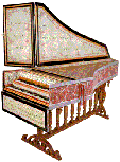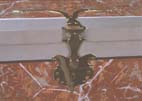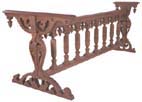![]()
|
Click on these images for more details:
|
Copy of a ‘French’ model Ruckers
harpsichord
Made in
Edinburgh by Grant O’Brien in 1985
Details of the original instrument This copy is based on the
so-called ‘French’ model of Ruckers harpsichord. The original instrument was made by Ioannes Ruckers in 1616 and
belongs to M. Nirouet in Paris. This
type of instrument was originally a transposing harpsichord with a
lower-manual compass of G1 to c3 and an upper-manual
compass of F to f3. The
two manuals were originally uncoupled and each played 1x8' and 1x4'.
The
original of the stand
seen under this copy is
located in the Berlin Musikinstrumentenmuseum and is found under the Andreas
I Ruckers double-manual harpsichord made in Antwerp in 1620 (Berlin
Musikinstrumentenmuseum Catalogue Number 2230).
Some details of the copy The copy of the Nirouet
Ruckers harpsichord has aligned keyboards with a compass of G1 to
d3. In order to give the
‘extra’ top note d3 which is necessary for a large part of the
harpsichord literature, the case was widened by the width of one
natural. The disposition is 2x8',
1x4' as follows:
The near two registers
of jacks including the dogleg are operated from
the upper manual. Because of the dogleg, the rear three registers are
available on the lower manual. The
rear two registers (at the top in the above diagram), played from the lower manual, pluck their strings at the
same point as on the original instrument.
The upper-manual 8' and the dogleg 8' jacks pluck the non-original added
(long) string. The two 8' jacks on
the lower manual pluck close together and therefore their sounds combine well
together (they are said to choir well).
When the dogleg 8' and the 4' are disengaged, the lower-manual 8' and
the upper-manual 8' can be played independently, but contrast well as they
are separated by the dogleg 8' jacks so that their relative plucking points
are considerably different .
The keyboards are balanced in the eighteenth-century fashion to give a lighter touch than that usual in the sixteenth and seventeenth centuries, and to take into account the fact that the lower-manual keys now lift three rows of jacks instead of the original two rows. The jacks are made in the way traditional for Ruckers and have ‘mouse-ear’ dampers and not the so-called ‘flag’ dampers common in most other traditions of harpsichord building. The stringing is in red brass, yellow brass and iron and the transition notes from one material to another have been calculated using the normal Ruckers transition scalings.
Drawing of this harpsichord for sale
Drawing of the lid decoration of this harpsichord for sale
Drawing of the stand of this harpsichord for sale
Drawing of a stand based on a Flemish table for sale
Ruckers book re-published in 2008. Buy a copy signed by the author.
|
|






